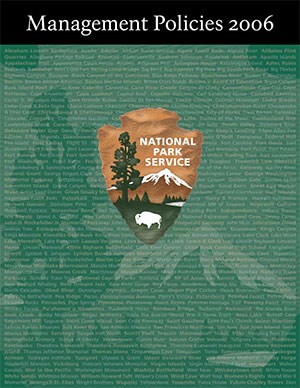
Several laws, mandates, policies and regulations provide the NPS with the authority and guidance to protect park resources, even if projects occur outside of the boundaries of units of the park system. The Organic Act of 1916 requires the NPS "[t]o conserve the scenery and the natural and historic objects and wild life therein and provide for the enjoyment of the same in such manner and by such means as will leave them unimpaired for the enjoyment of future generations " (16 U.S.C. 1). Furthermore, NPS Management Policies Section 1.4.5 states that "Impairment may also result from sources or activities outside the park." As such, the NPS has a legal obligation to protect park natural, historic, and cultural resources from impacts, including those that result from external renewable energy projects. Critical actions for the NPS include early involvement in the planning and project-specific decision-making processes of project developers and regulatory agencies at the federal, state, regional and local levels.
The NPS also has responsibility over special status areas such as National Historic Trails, Wild and Scenic Rivers, Wilderness Areas, National Natural Landmarks, National Historic Landmarks, National Heritage Areas, National Heritage Corridors, and lands acquired under the Land and Water Conservation Fund Program and the Federal Lands to Parks Program.
While the NPS supports the development of alternative energy and the overall reduction of greenhouse gas emissions, including the need for transmission infrastructure in support of those projects, the NPS' primary obligation is to protect park (and associated area) values from potential adverse effects of adjacent development.
A reduction in greenhouse gas emissions and conversion to a more sustainable energy future will benefit national parks and the nation as a whole. Several congressional mandates, federal policies, and executive orders encourage the use of renewable energy. These federal policies establish long-term goals to accelerate the installation and capacity of various renewable energy technologies such as solar and wind (both offshore and onshore).
Beginning in 2005, the Energy Policy Act established a goal for the Secretary of Interior to approve 10,000 megawatts of electricity from non-hydropower renewable energy projects located on public lands. Since that time, other guidelines and requirements have influenced NPS support of renewable energy, including but not limited to the Energy Independence and Security Act, and Executive Orders 13423 and 13514.
In 2013, President Obama released a Presidential Memorandum on Federal Leadership on Energy Management, which established a new target for all federal agencies to source 20 percent of their total electric energy from eligible renewable energy resources. In the same year, the Executive Office released the President's Climate Action Plan, which called on the Department of the Interior to accelerate clean energy leadership and increase renewable energy permitting by 10 gigawatts by 2020.
Related Resources
- National Park Service Management Policies 2006 [2.5 MB PDF]
- Executive Order 13423, "Strengthening Federal Environmental, Energy, and Transportation Management"
- Executive Order 13514, "Federal Leadership in Environmental, Energy, and Economic Performance"
Last updated: September 21, 2016
